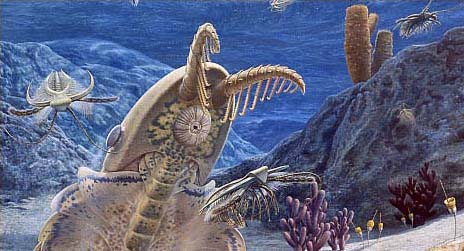 |
 |
 |
 |
 |
Produced
by the Population Genetics and Evolution class, Furman University |
||||
 |
 |
 |
 |
 |
Produced
by the Population Genetics and Evolution class, Furman University |
||||
 |
The
Cambrian: Sidneyia |
 |
||
| Sidneyia
inexpectans was discovered in 1909 by Charles D. Walcott and is one
of many species found in the Burgess Shale Formation, in British Columbia
(Smithsonian Institution 2010). This organism was the first fossil that
Walcott found during his excavation of the Burgess Shale and was named
after his oldest son, Sidney (Wikipedia 2009). Burgess Shale fossils,
such as Sidneyia, are estimated to be 505 million years old,
placing this species in the middle upper Cambrian period (The Virtual
Fossil Museum 2002). As indicated in the images to the right, Sidneyia’s
body is made up of a “cephalon with stalked eyes, a thorax of nine
articulating somites, and a cylindrical abdomen of two or three somites
terminating with a pair of uropods articulating at the posterior margin
of the last abdominal somite” (Bruton 2001). The jointed legs and
the gnathobase of Sidneyia indicate that this organism was a
bottom dwelling arthropod; however, its telson and caudal fan were most
likely used for swimming (Bruton 1981). This benthic arthropod ranged
from 2-5 inches in size and although small, it was one of the larger predators,
(Smithsonian Institute 2010) and fed on small crustaceans such as hyolithids
and trilobites as indicated by fossilized gut contents (Bruton 1981).
While Sidneyia’s body plan and lack of cheliera make it
a unique species, it is the earliest known species that could be an ancestor
to merostomes (Bruton 1981).
Page by Chapin Hardy |
 |
| Sidneyia inexpectans. Photo credit: The Smithsonian Institution | |
|
Bruton DL. 2001. A death assemblage of priapulid worms from the Middle Cambrian Burgess Shale. Lethaia, Vol. 34: 163–167. Bruton DL.1981. The Arthropod Sidneyia inexpectans, Middle Cambrian, Burgess Shale, British Columbia. Phil.Trans. Roy. Soc. B: 295:619-653. Smithsonian Institution. 2010. Burgess Shale: Sidneyia inexpectans (an arthropod). Accessed January 31, 2010. Virtual Fossil Museum. 2002. Fossils from the Burgess Shale of British Columbia, Canada. Accessed February 1, 2010. Wikipedia. 2010.Sidneyia. Accessed January 31, 2010. |